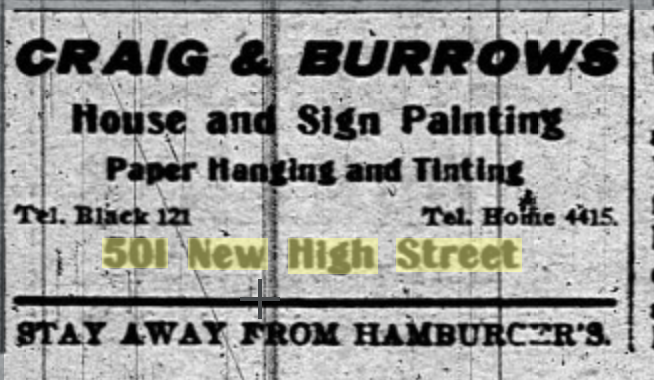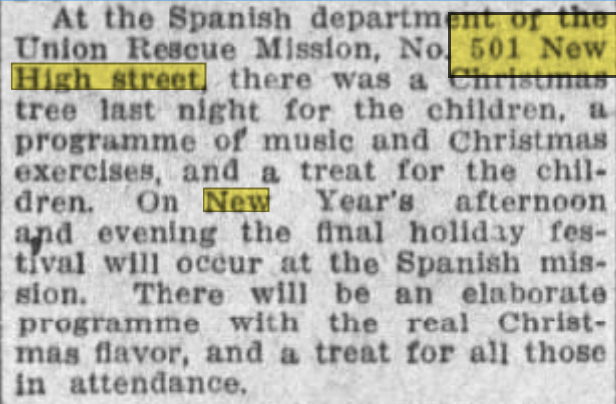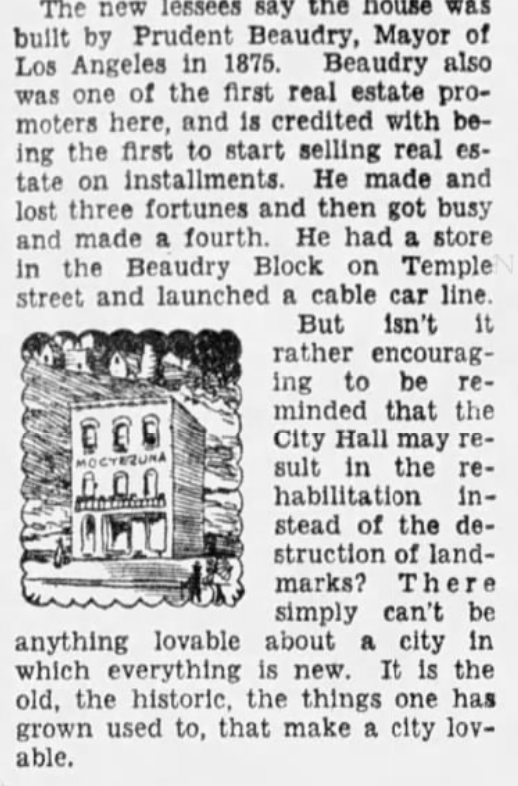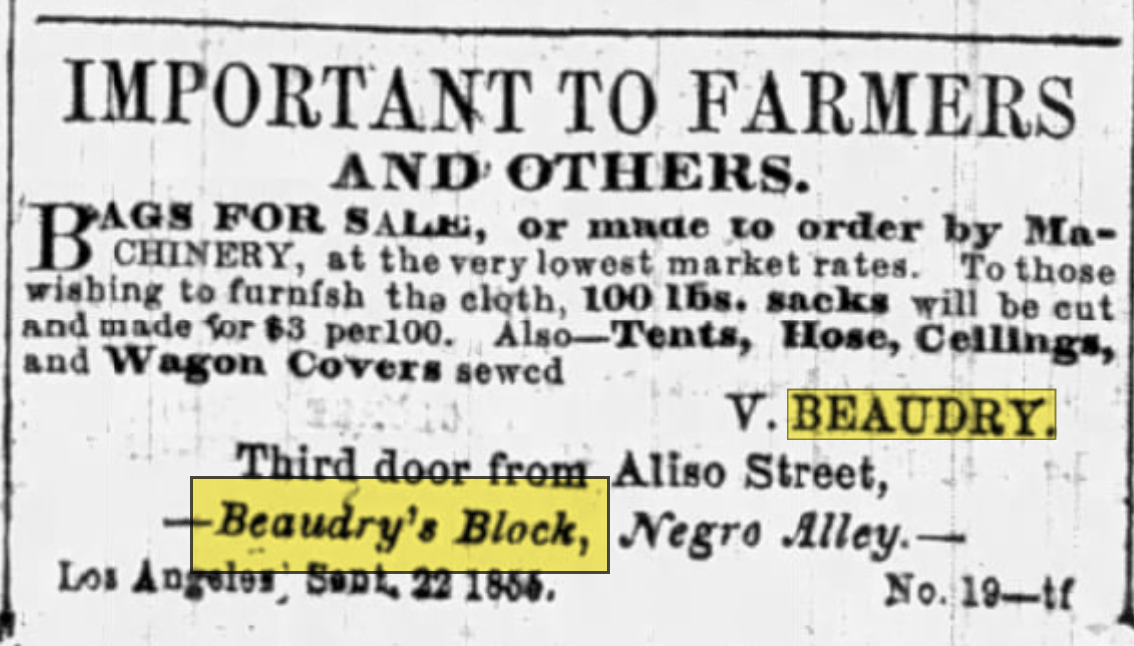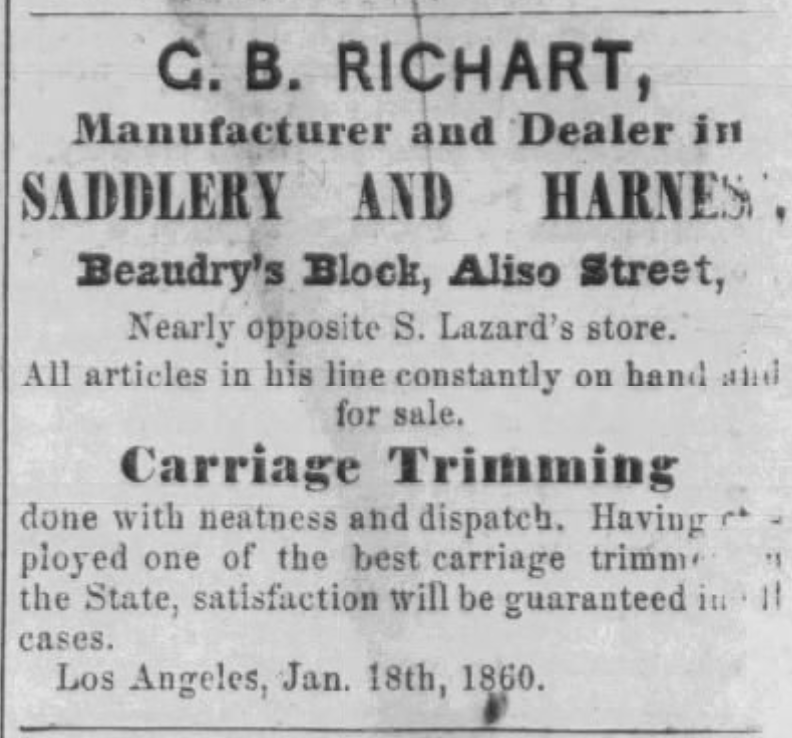If you're on Twitter and aren't following LAPL's Photos account, you're missing some great pictures of old LA. And you may learn a thing or two that you didn't already know.
I was somehow not aware that there used to be a French-themed event in my family's longtime neighborhood.
In the 1950s, "April in Paris" was held annually in Sherman Oaks. Ventura Boulevard was even dubbed Montmartre Boulevard - or the Champs-Elysées, depending on which year it was. (Strictly speaking, there isn't a Montmartre Boulevard in Paris. There is a Boulevard Montmartre.) "April in Paris" was, of course, the title of a popular 1952 film starring Doris Day and Ray Bolger.
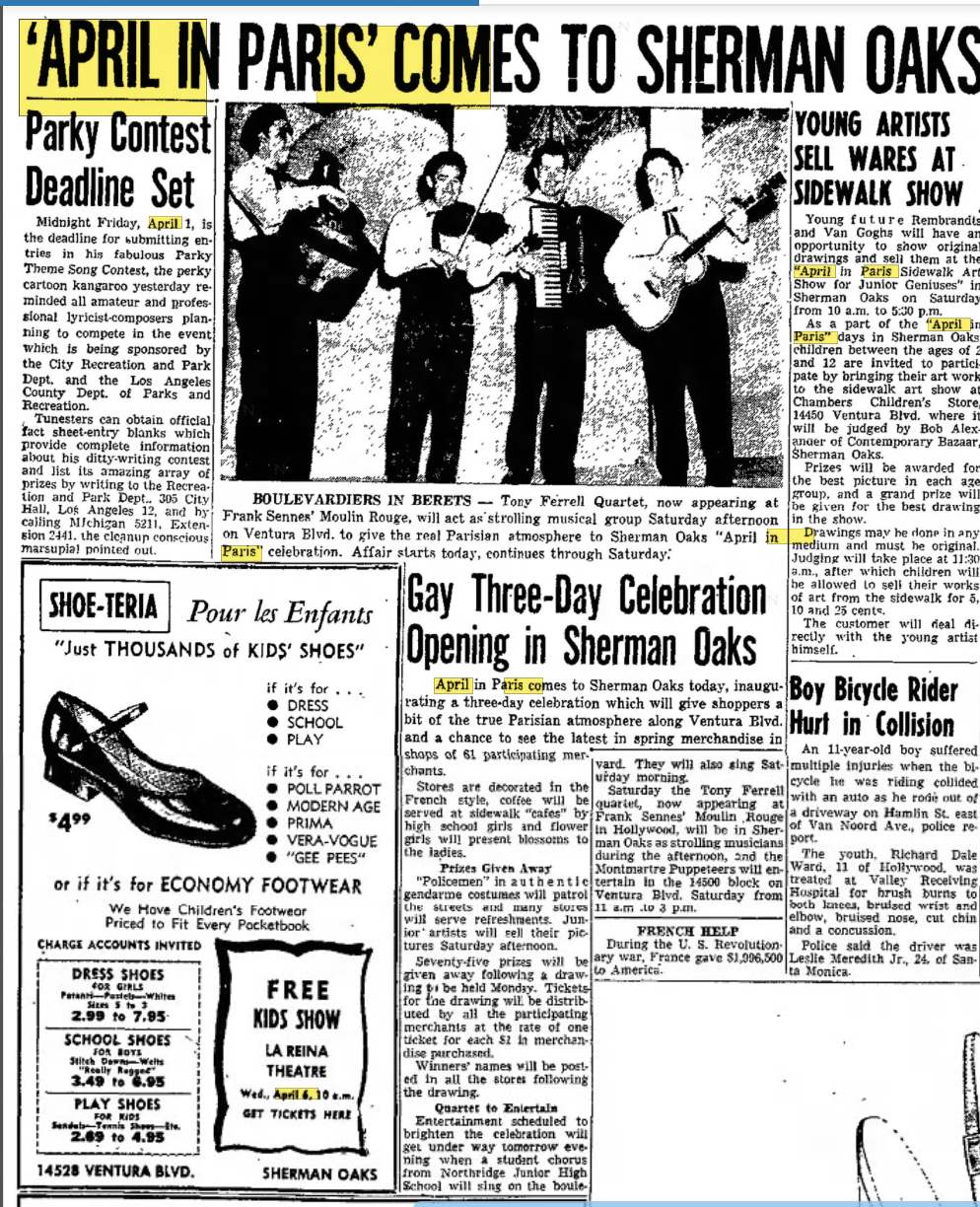 |
| 1955 article on "April in Paris" festival. Do note that it mentions "During the U.S. Revolutionary War, France gave $1,996,500 to America." |
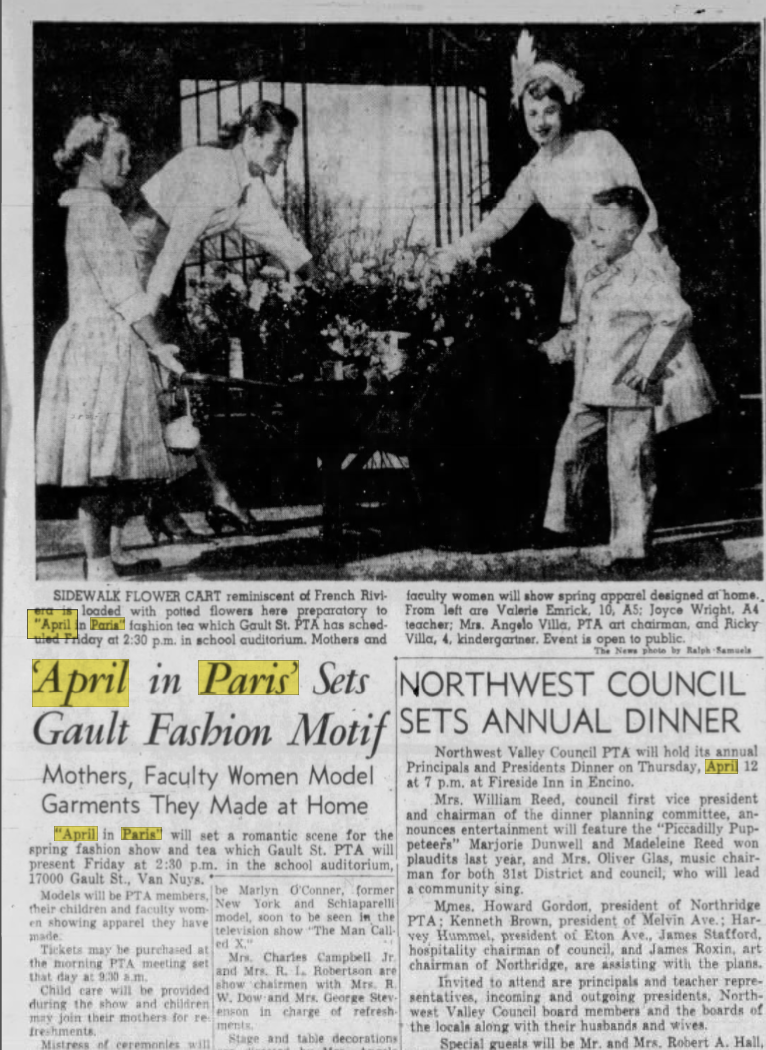 |
| "April in Paris" fashion show, 1956 |
"April in Paris" may well have inspired a separate fashion show a few weeks before the 1956 event. The Gault Street Elementary School PTA held a French-themed after-school fashion show with the same name (it was a popular theme for parties, dances, luncheons, etc. in the '50s) as a fundraiser. Gault Street Elementary School is, of course, several miles away in Van Nuys.
Per a 1956 article, the first event was held in 1954. The 1956 festival, spanning three days, re-dubbed Ventura Boulevard the Champs-Elysées, adorned the entire business district to resemble Paris, and set up art exhibits. Shops had live models informally showing the latest spring and summer fashions, displayed the various prizes to be awarded, and competed to win decorating contests. Gendarmes handed balloons to children. A special screening of the festival's namesake film, "April in Paris", capped off the weekend.
 |
| 1956 newspaper article outlining April in Paris festival |
 |
| "Miss Sherman Oaks", aka Pat Fowley, holds the ladder while fellow Valley resident Liberace (really!) turns Ventura Boulevard into the Champs-Elysées, 1956. |
The grand prize that year was an O'Keefe & Merritt gas stove with a rotisserie, proudly displayed at the La Reina theatre, now the Studio City Barnes & Noble. (Note to readers outside of Southern California or who are younger than I am: O'Keefe & Merritt was a stove manufacturer based in Los Angeles and is still known for high quality despite being long-defunct.)
The 1957 "April in Paris" event lasted an entire month, including contests, sales, celebrity appearances, and a "Poodle Parade" with 400 dogs. One of the prizes was, of course, two tickets to Paris. It seems to have primarily been a way to promote spring sales, but so what?
 |
| April in Paris coverage, 1957 |
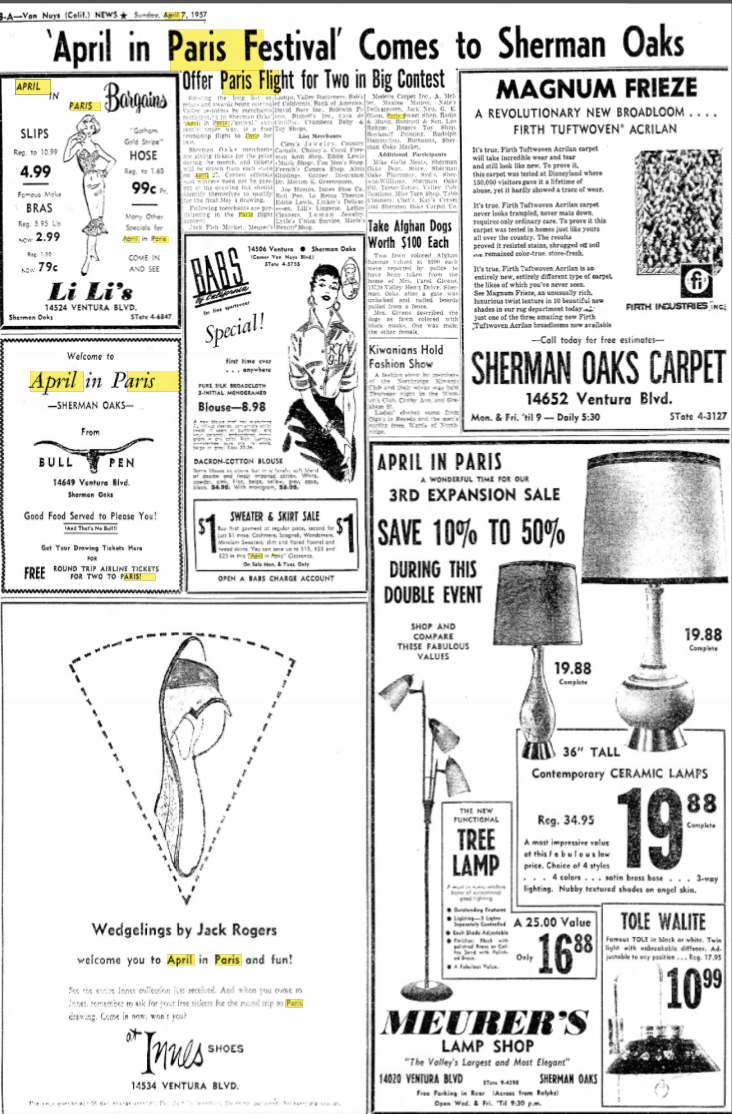 |
| 1957 article on, and ads for, the April in Paris festival |
 |
| 1957 clipping mentioning "Honorary Mayor Liberace" kicking off the festivities |
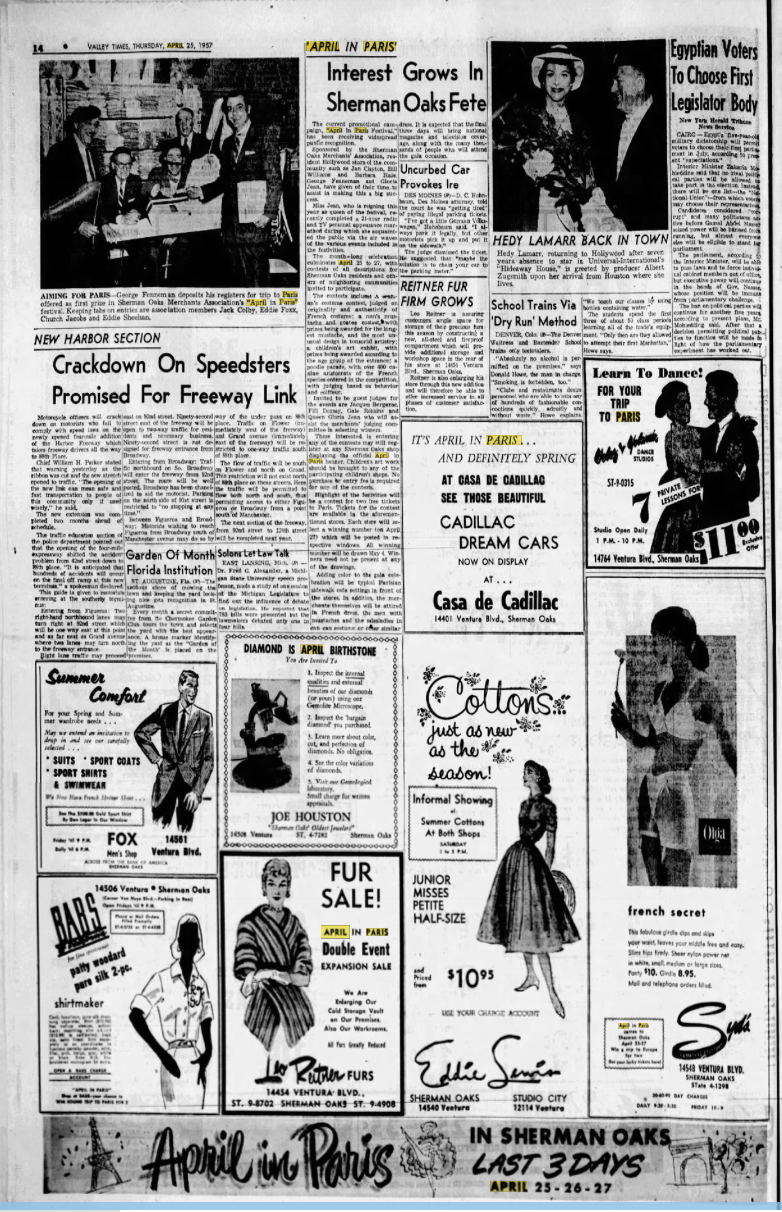 |
| Valley Times page with article on, and multiple ads relating to, April in Paris |
As you can see from the Valley Times page above, merchants participating in the April in Paris promotion included several apparel stores, a jeweler, a dance studio, and even Casa de Cadillac.
 |
| 1958 "April in Paris" article and photo |
 |
| 1958 ad for the April in Paris event. |
Contests were also a component of April in Paris, ranging from French costume to children's artwork to growing facial hair (really). The grand prize for 1958, a 21" color television, would have been quite a draw indeed. A color television was an expensive luxury item in 1958. For context, my grandparents couldn't afford one until 1967, and at the time it cost $500 or $600 (around $5,000 in 2023 money).
The event seems to have varied from one year to the next. 1958 saw two weeks' worth of celebrations in Sherman Oaks, capped off with the Poodle Parade. In 1959, the Sepulveda-Panorama Inter-Club Council sponsored a dance.
Sidewalk cafes appeared. (There was a time when alfresco dining was far less common in LA, despite the usually-perfect weather.)
 |
| 1958 news clipping with a picture of a sidewalk cafe setup. |
French figurines added to the atmosphere of a benefit fashion show. (It's hard to tell from the photos, but that figurine does look like Pierrot.)
By 1962, "April in Paris" lent its name not to a festival, but to a French-inspired dance sponsored by the Women's Council at Our Lady of Lourdes church. Our Lady of Lourdes is in Northridge, but the dance was held at the VFW hall in Canoga Park (which is now a Knights of Columbus hall). Hostesses in questionably authentic cancan costumes greeted attendees, Andre's restaurant catered a filet mignon dinner, and dancing followed. (While Andre's is a solidly Italian restaurant, it's worth noting that founder and chef Domenic Andreone trained at Le Cordon Bleu. I suspect the long-shuttered Beverly Hills location catered the dance, since the longtime Third Street location didn't open until 1963.)
A 1956 article concluded "Business men in the community are already cultivating their accents, goatees, and mustachios for the big event and vow to eat their berets if Sherman Oaks doesn't out-'Gay Paree' Gay Paree." Well, I'll eat my beret if Sherman Oaks ever does anything like "April in Paris" again. Remember, LA has rudely ignored Bastille Day since 1968. I doubt Ventura Boulevard merchants would get too enthused about pretending to be Parisians when it’s much easier to just have a sale or hold a raffle, and I’m sure that, like most Angelenos, many are unaware of the Valley’s French roots.
But if anyone out there wants to prove me wrong, I'll be only too happy to judge the costume contest.






